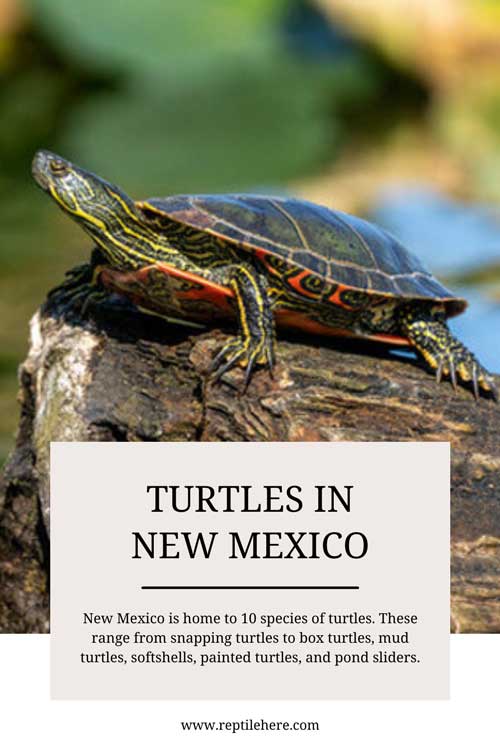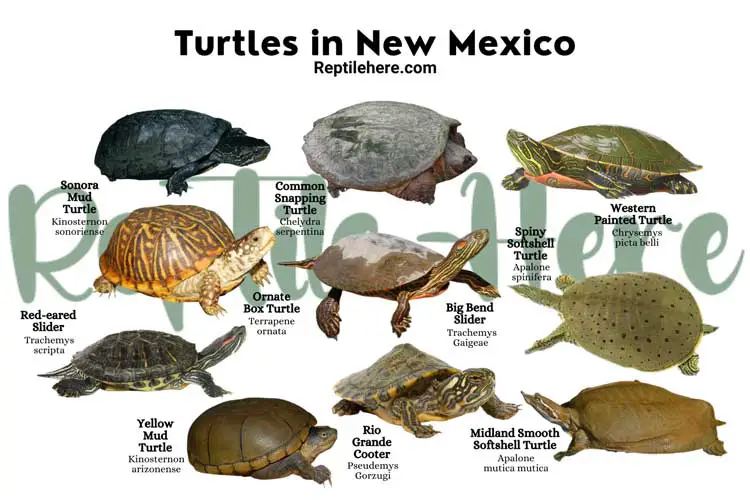Turtles in New Mexico – 10 Species That are Found Here
New Mexico is home to 10 species of turtles. These range from snapping turtles to box turtles, mud turtles, softshells, painted turtles, and pond sliders.
Most of these turtles (8 of them, to be precise) are native to the region. The remaining two are non-native species and include the red-eared slider and common snapping turtles.
These invasive turtles most likely found themselves in New Mexico’s wild through pet releases by unprepared pet owners.
Below is the complete list of the turtles of New Mexico and the key facts you need to know about each of them.
We have covered basics about each species like habitat, lifespan, average adult size, diet, and more.
10 Types Of Turtles In Mexico
Contents
1. Common Snapping Turtle
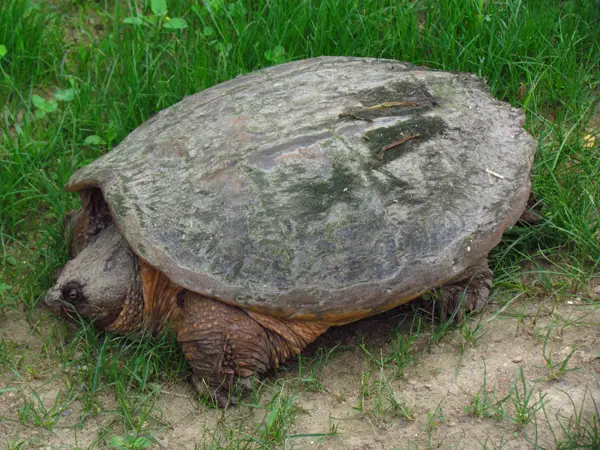
- Scientific name: Chelydra serpentina
- Common name: Snapping Turtle
- Family: Chelydridae
- Size: 8 to 18 1/2 inches
- Lifespan: 30 to 50 years or more
- Conservation status: Least Concern
The common snapping turtle is one of the most popular turtle species across the US states and is also found within the borders of New Mexico. It is non-native to the state and is mainly found in the northeastern and central parts of the state.
Common snapping turtles in New Mexico are unprotected and can be legally owned as pets.
An average common snapping adult turtle is pretty large and has a shell length of 18½ inches long. It is easily recognizable for this large size plus an intimidating appearance!
This species has a chunky head, a long tail, strong claws, and large webbed feet. The shell color is black or olive and has no distinct pattern. These New Mexico snapping turtles are also known for their hook-like powerful jaws—they’re so strong that these turtles eat other turtles!
You’ll find them in waterbodies with muddy bottoms. Examples include marshes, ponds, lakes, rivers, and even shallow streams. They generally prefer waters with aquatic vegetation in plenty and foods such as fish, frogs, birds, etc.
These New Mexico turtles generally show docile behavior but can get quite aggressive if taken out of water. The best way to calm it is to take it back to the waters, where it feels safe.
2. Western Painted Turtle
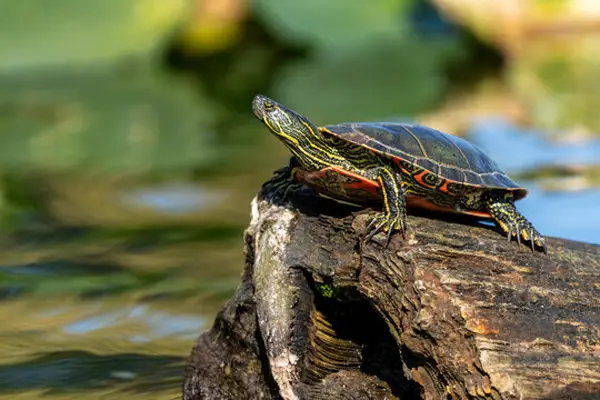
- Scientific name: Chrysemys picta belli
- Common name: Westland Painted Turtle
- Family: Emydidae
- Size: 4 to 10 inches
- Lifespan: 30 to 40 years
- Conservation status: Least Concern
The Western painted turtle is a subspecies of painted turtle and a native species of New Mexico waterbodies.
This turtle is identified by an oval-shaped carapace that lacks a ridge in the middle. The carapace is usually dark olive or black in color.
The lower side of the shell is usually red, with multiple dark markings in the center. And the skin itself is covered with yellow stripes.
Westland painted turtles of New Mexico are aquatic and their webbed feet help propel them in the waters.
The most common habitats for this turtle in New Mexico include slow-moving rivers, shallow streams, and lakes. They choose these areas because they can easily find food.
Given that they’re omnivorous, they feed on aquatic vegetation as well as meat from insects, snails, shrimps, tadpoles, and earthworms.
Their hatchlings are more carnivorous to help take in more proteins for building muscle.
3. Midland Smooth Softshell Turtle
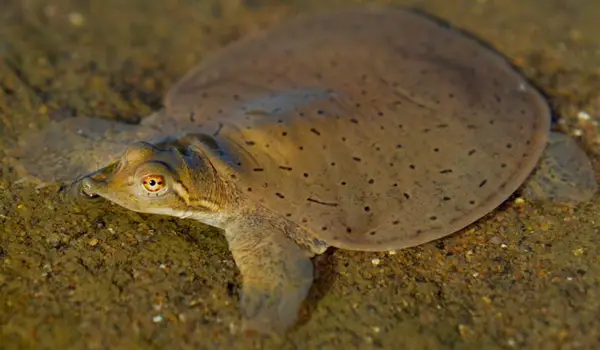
- Scientific name: Apalone mutica mutica
- Common name: Midland Smooth Shell
- Family: Trionychidae
- Size: 6 to 13 inches
- Lifespan: 40 to 60 years
- Conservation status: Least Concern
The midland smooth softshell turtle boasts its position as the fastest turtle on land in New Mexico! It is mainly found in select New Mexico northeastern counties.
Though most people believe these turtles are slow-moving, they must be quick to enable them to outrun their predators given that their soft shells don’t offer much protection.
Shell color of this turtle species ranges from olive to dark brown. The upper part of its shell features dark markings (with female markings appearing in a blotchier pattern than the males’)
The shell of these turtles also appears rounder and flatter, just like other softshell species.
These turtles like inhabiting waterbodies like rivers and streams in New Mexico that provide an abundance of mud or sand at the bottom. They can also be found in stagnant waterbodies.
Midland smooth softshell turtles are omnivorous and their diet revolves around aquatic vegetation and insects. However, they have been observed to like meat more than plant matter and will mainly eat snails, insects, and fish.
4. Spiny Softshell Turtle
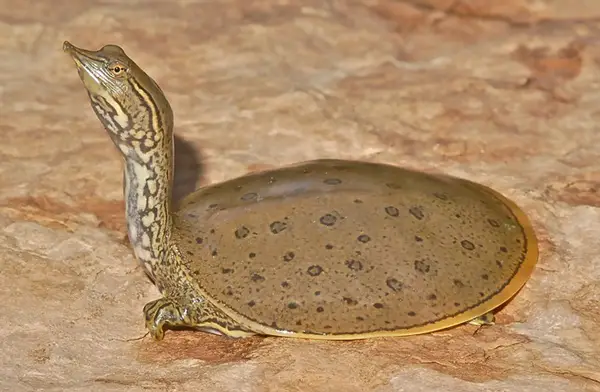
- Scientific name: Apalone spinifera
- Common name: Spiny Softshell Turtle
- Family: Trionychidae
- Size: 5 to 9 inches (males), 12 to 20 inches (females)
- Lifespan: 30 to 70 years
- Conservation status: Least Concern
The Spiny softshell turtle is a medium-to-large freshwater species that live in New Mexico’s lakes, streams, and rivers with muddy or sandy bottoms and little or no vegetation.
Female spiny softshell turtles are usually larger than males. And unlike other turtles, this species has a flexible, leather-like carapace that’s extremely rounded and flattened. The shell color can be olive grey or yellow-brown.
Just like other softshell turtles, this species also has a snorkel-like snout.
The young ones feature well-defined round spots that are easily visible on the shell (though these spots become invisible as they transition to adulthood).
Spiny softshell turtles in New Mexico tend to eat anything they find in the waters including crayfish, insects, small fish, and so on. They hunt by burying themselves in the mud or sand while keeping their head uncovered to grab food as it swims by.
These turtles are also able to breathe underwater by taking in oxygen through their throat skin. This is a useful adaptation given that they don’t spend a lot of time out of water.
Other adaptations of these turtles include webbed feed, long claws, and extremely flat shells that enable them to quickly swim away from predators and burry in the muddy bottom of the waters they reside in.
Also read: Turtles in Michigan
5. Sonora Mud Turtle
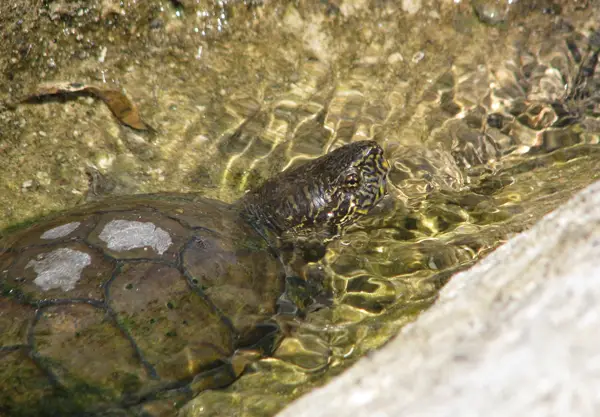
- Scientific name: Kinosternon sonoriense
- Common name: Sonora Mud Turtle, Mud Turtle
- Family: Kinosternidae
- Size: 5 to 7 inches
- Lifespan: 30 to 50 years
- Conservation status: Near threatened
This turtle likes spending most of its time in water and is fond of creeks, streams, and even stock ponds in New Mexico.
It is a pretty isolated species and won’t be found in many areas apart from Arizona, Mexico, and New Mexico.
A Sonora mud turtle is identified by its brown skin with yellow lines. The upper shell is olive-brown in color and has keels on it.
Similar to most other mud turtles, these turtles are omnivorous and like feeding on small insects and animals as well as vegetation.
Although this turtle species was once widespread, its range and population have been on the decline owing to habitat loss due to human intervention.
For this reason, the Sonora mud turtle in New Mexico has been labeled a “Near Threatened” species and is under special protection.
Thus, spotting one in the wild in New Mexico will mean you’re quite lucky. And we caution you to be extra careful in your observations!
6. Yellow Mud Turtle
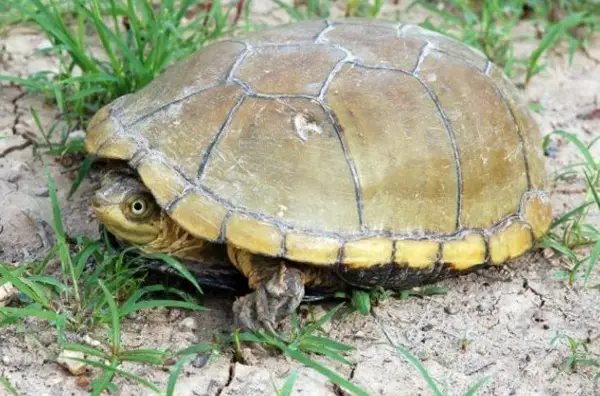
- Scientific name: Kinosternon arizonense
- Common name: Yellow Mud Turtle, Mud Turtle
- Family: Kinosternidae
- Size: 4-5 inches
- Lifespan: 40 years
- Conservation status: Least concern
The Yellow mud turtle is a species native to New Mexico and prefers living in any waterbody you can come across in New Mexico state.
Possible places you can find it includes muddy pools, cattle tanks, irrigation ditches, sewer drains, and even cisterns!
This turtle will spend more time on land migrating to new water sources and is never picky about where it can stay.
It has a flattened upper shell with colors varying from brown to black or olive. It also features dark brown edges around its scutes. The skin color is usually olive.
Males have a sharp or horny end as a distinctive feature.
This New Mexico yellow mud turtle is omnivorous like any other mud turtle. Its diet is made up of a variety of foods including tadpoles, leeches, crayfish, fairy shrimp, and fish.
It will also eat frogs, slugs, and snails. And as an opportunistic feeder, it will also eat decaying animal and plant matter.
7. Rio Grande Cooter
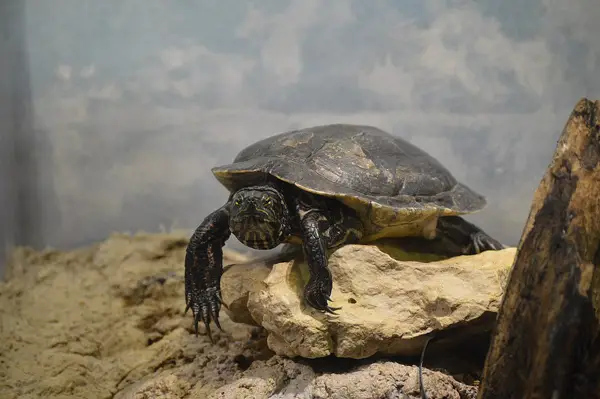
- Scientific name: Pseudemys Gorzugi
- Common name: Western River Cooter, Rio Grande River Cooter
- Family: Emydidae
- Size: 8 to 12 inches
- Lifespan: 20 to 40 years
- Conservation status: Near Threatened
The Rio Grande Cooter is a semi-aquatic turtle that inhabits the southeastern regions of New Mexico.
It is mainly found in larger ponds and rivers with decent depths. It gets its name from the Rio Grande river in New Mexico and Texas, where it has been spotted.
This Cooter is easily identified by its shell which is usually olive green or dark brown, or even black. Its rearward scutes also appear slightly jagged. The Swirling patterns of red, orange, or yellow lines can also be seen. As for the plastron, it’s usually yellowish or reddish.
A Rio Grande Cooter in New Mexico is usually omnivorous and prefers eating plants and vegetation. On an occasional basis, however, it can be seen eating mollusks or invertebrates.
Unfortunately, the population of this Cooter in New Mexico continues to decline due to pollution as well as water diversion projects. This explains why it has near-threatened conservation status.
8. Red-eared Slider
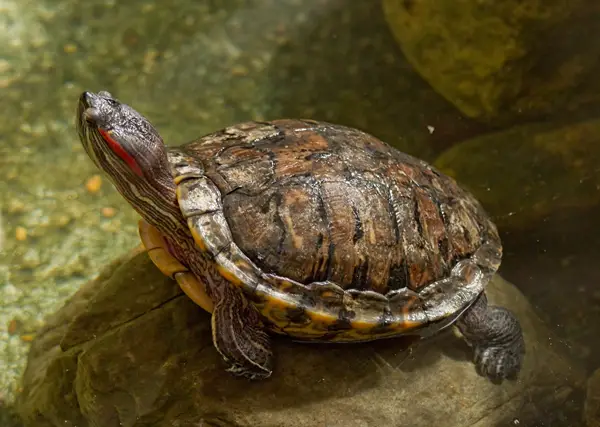
- Scientific name: Trachemys scripta
- Common name: Red-eared Slider, Red-eared Terrapin
- Family: Emydidae
- Size: 7 to 11 inches
- Lifespan: 30 to 40 years
- Conservation status: Least Concern
The red-eared slider is a sub-species of pond sliders and a non-native species of New Mexico. It is a semi-aquatic turtle and prefers living in marshes, ponds, lakes, and creeks.
A red-eared slider gets its name from the small red stripe surrounding its ears (or behind the eye), and its ability to quickly slide off logs and rocks into the water.
Generally, the skin and shell coloration of this slider can be brown or black, with yellow stripes covering the skin.
The red-eared sliders of New Mexico are pretty large and the adults reach 7-12 in length (though females are generally larger than males).
These New Mexico pond sliders are omnivorous and like eating fish, snails, insects, and aquatic vegetation. They also eat land vegetation, including fruits and vegetables.
9. Big Bend Slider
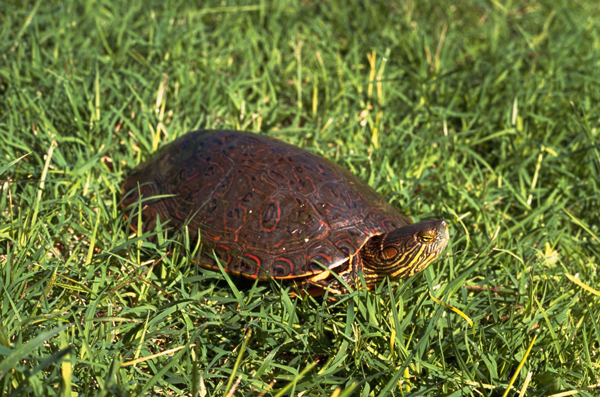
- Scientific name: Trachemys Gaigeae
- Common name: Big Bend Slider, Mexican Plateau Slider
- Family: Emydidae
- Size: 5 to 11 inches
- Lifespan: 20 to 30 years
- Conservation status: Vulnerable
The big bend slider, also known Mexican plateau slider, is another semi-aquatic turtle native to select central counties of New Mexico state.
It is pretty close in appearance to its close cousin, the red-eared slider, with the exception that it has fewer red patches around its eyes.
The big bend slider’s upper shell color ranges from olive to dark brown and is covered with a yellow, orange, or red pattern. And the lower side of the shell is yellowish with a few dark spots.
Skin color is usually the same as the carapace and is covered in yellow stripes. Two red spots can be easily spotted on each side near its head.
You’ll find this big bend slider in the pond and rivers of New Mexico. The turtle is also fond of basking.
Mexican plateau sliders in New Mexico are mainly herbivorous and like feeding on vegetation as well as fruits, unlike their counterparts (the red-eared sliders) which are omnivorous.
10. Ornate Box Turtle
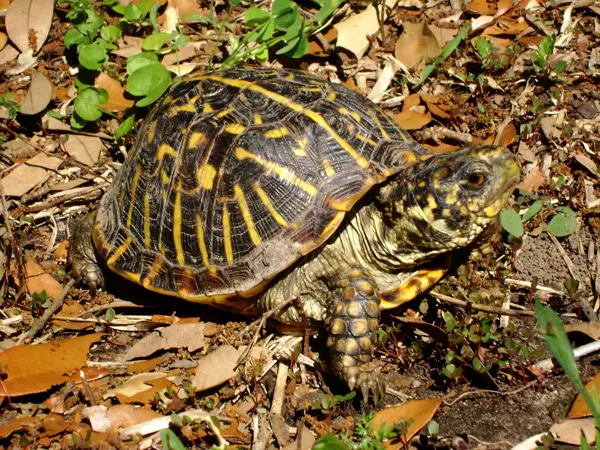
- Scientific name: Terrapene ornata
- Common name: Ornate Box Turtle
- Family: Emydidae
- Size: 5 to 7 inches
- Lifespan: 40 to 60 years
- Conservation status: Near Threatened
Ornate box turtles are present in New Mexico and are recognized by the beautiful pattern on their carapace. This eye-pleasing pattern is sometimes referred to as a starburst pattern.
Their skin is grey and may feature yellow or white spots. Male heads occasionally feature a green color.
Though there exists a little distinction between the males and females of these New Mexico box turtles, the males are generally smaller than the females.
During hot weather, this turtle requires water to help regulate its body temperature.
The New Mexico species of turtle are known to hibernate in burrows during cold weather. They’re also capable of surviving in frozen soils for several days.
Being omnivorous in nature, and opportunistic feeders, these turtles will gladly eat anything available to them in their habitat or what’s abundant in a given season.
They have been observed eating fruits, vegetables, grasshoppers, and various other insects.
Also, these box turtles are pretty shy and don’t like being handled excessively. As such, you may want to avoid approaching them suddenly while in the wild in New Mexico.
Related: Turtles in Colorado
Conclusion
Just like any other state, New Mexico enjoys its fair share of turtle species. It has both native and non-native species spread across various parts of the state.
The native species include softshells, painted turtles, Cooters, box turtles, mud turtles, the big bend sliders, and box turtles.
Non-native turtles are only two and include the red-eared slider and common snapping turtle.
We hope that this list has answered all your questions regarding the turtles of New Mexico and the unique traits each of them carries.
